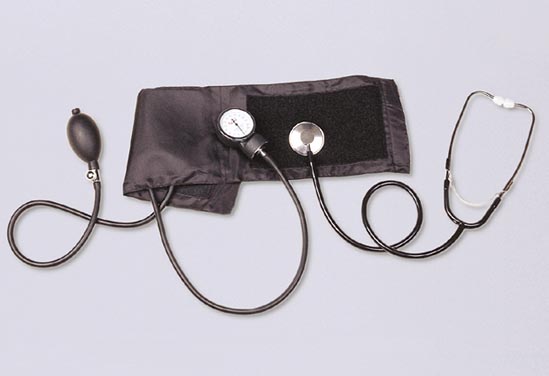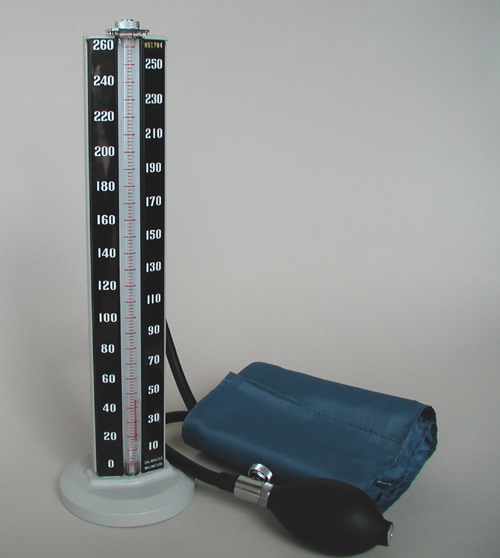Sphygmomanometer
Overview

A sphygmomanometer (often condensed to sphygmometer[1]) or blood pressure meter is a device used to measure blood pressure, comprising an inflatable cuff to restrict blood flow, and a mercury or mechanical manometer to measure the pressure. It is always used in conjunction with a means to determine at what pressure blood flow is just starting, and at what pressure it is unimpeded. Manual sphygmomanometers are used in conjunction with a stethoscope.
The word comes from the Greek sphygmós (pulse), plus the scientific term manometer (pressure meter). The device was invented by Samuel Siegfried Karl Ritter von Basch. Scipione Riva-Rocci, an Italian physician, introduced a more easily used version in 1896. Harvey Cushing discovered this device in 1901 and popularised it.
A sphygmomanometer usually consists of an inflatable cuff, a measuring unit (the mercury manometer), a tube to connect the two, and (in models that don't inflate automatically) an inflation bulb also connected by a tube to the cuff. The inflation bulb contains a one-way valve to prevent inadvertent leak of pressure while there is an adjustable screw valve for the operator to allow the pressure in the system to drop in a controlled manner.
Operation
The cuff is normally placed around the upper left arm, at roughly the same vertical height as the heart while the subject is in an upright position. The cuff is inflated until the artery is completely occluded. Listening with a stethoscope to the brachial artery at the elbow, the examiner slowly releases the pressure in the cuff. As the pressure in the cuffs falls, a "whooshing" or pounding sound is heard (see Korotkoff sounds) when bloodflow first starts again in the artery. The pressure at which this sound began is noted and recorded as the systolic blood pressure. The cuff pressure is further released until the sound can no longer be heard and this is recorded as the diastolic blood pressure.
Significance
The peak pressure in the arteries during the cardiac cycle is the systolic pressure, and the lowest pressure (at the resting phase of the cardiac cycle) is the diastolic pressure.
Types
There are two types:
- Digital (electronic, easy to operate and practical in noisy environment. Many have not been validated for all patient groups, and can give very inaccurate readings).They measure mean arterial pressure, MAP, and use algorithms to calculate systolic and diastolic values. In this sense, they do not actually measure the blood pressure, but derive the readings. Digital oscillometric monitors are also confronted with “special conditions” for which they are not designed to be used : arteriosclerosis, arrhythmia, preeclampsia, pulsus alternans, and pulsus paradoxus.
- Manual (older fashioned, though more precise). Must be operated by a trained person.
Mercury manometers are considered to be the "Gold Standard" of measurement because they do not go out of calibration. For this reason they are often required in clinical trials of pharmaceuticals and for clinical evaluations of determining blood pressure for high risk patients including pregnant women. Aneroid, mechanical, types are in common use, but should be checked against a mercury manometer if they are suspected to be out of calibration.
Gallery
-
Mechanical sphygmomanometer with aneroid manometer and stethoscope
-
Mercury manometer
See also
More detail is given in the article on blood pressure.
Patents
- U.S. Patent 2,560,237 : R. H. Miller : "Sphygmomanometer"
- U.S. Patent 6,752,764: Man S. Oh: "Pocket sphygmomanometer"
ca:Esfigmomanòmetre de:Blutdruckmessgerät fa:بازوبند فشار خون it:Sfigmomanometro nl:Bloeddrukmeter pms:Sfigmomanòmeter sl:Sfigmomanometer fi:Verenpainemittari

